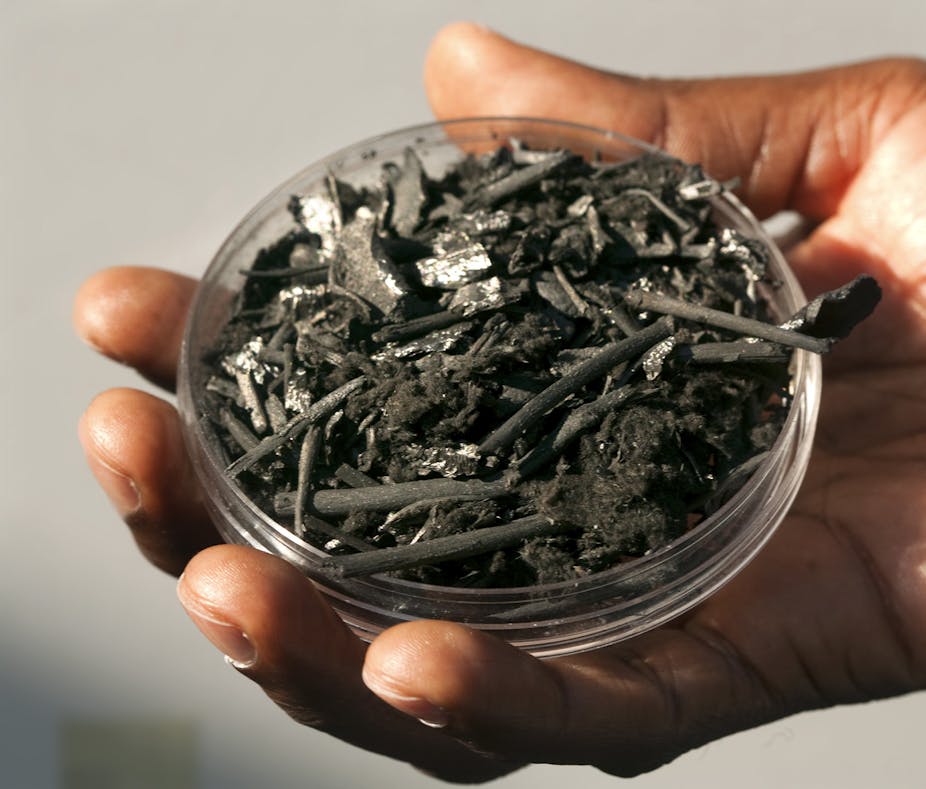October 13, 2019 6.32pm AEDT,
Author

A sample of biochar NCAT CAES/Flickr
Farmers in countries like Uganda could help fight climate change – and improve their crop yields – by adding agricultural waste to their fields. The process removes carbon from the atmosphere and stores it in the soil.
It’s a strategy proposed under the United Nations Framework Convention on Climate Change and shown to have strong potential, especially in sub-Saharan Africa, in recent research done by myself and colleagues from Makerere University in Uganda and the University of Natural Resources and Life Sciences in Austria.
Soils can absorb carbon dioxide from the air through a process called carbon sequestration. This is when more carbon is added to the soil than it loses. Carbon dioxide is lost from soils to the atmosphere when plant material, manure and other organic matter decomposes.
Biochar – plant matter that’s been burned using only a little oxygen – is an excellent way to add carbon to soil. Many of the world’s soils already hold charred organic matter which originates from natural and human-made vegetation fires. Biochar is good at storing carbon in soils because its natural breakdown happens very slowly, unlike raw residues or manure. This means it can remove carbon from the atmosphere over a long period of time.
A number of carbon sequestration projects using biochar are already taking place in North and South America, Asia and Europe. For instance by 2020, using biochar from the natural waste of home gardens and public parks, Sweden’s capital city will remove as much carbon dioxide as 3,500 cars emit in a year.
In sub-Saharan Africa, biochar from farming residues – like husks, hulls, leaves, branches and straw – could be used for the same purpose. But few studies have assessed how much of this material is available for biochar and how much carbon it could store in soils.
In our paper we shed more light on this. We looked at how much residue was left over from maize, sorghum, rice, millet and groundnut crops on eastern Ugandan farms.
We found that, when converted into biochar, these “leftovers” have significant potential for storing carbon in soils. Adding biochar from crop residues to soil on one hectare (2.5 acres) of land could offset between 16% and 80% of the 4.6 tons of carbon dioxide emitted by one vehicle in the US each year.
Biochar has the added benefit of improving soil fertility and crop production in tropical climates. So this strategy – to use biochar to remove warming gases from the atmosphere – will benefit farmers.
Making biochar
When crops grow and are harvested, they leave behind large amounts of residue which has many valuable uses: it can be added to soil to make it more fertile, or used in animal feed, for construction, or to generate heat and power.
Despite its uses, farmers in sub-Saharan Africa burn a lot of crop residues in fields because recycling the waste involves time, labour and machinery that they can’t afford.
But it need take only hours or a few days to collect residues and make biochar. And it doesn’t have to involve expensive technology.
When biomass is exposed to temperatures between 300°C and 800°C with little, or no, oxygen present it is converted into combustible gases, oils and biochar.
There is a broad range of systems that can carry out this process. Some are basic, such as domestic cook stoves that have a chamber with a natural or forced air draft. Other systems may be larger and more complex, generating heat and electricity through highly controlled processes. These can serve whole communities.
Using these systems, biochar can be generated from crop residues and mixed directly into agricultural soils, if done cautiously.
Potential of biomass waste
In our study, we measured the residues produced by five crops over two growing seasons.
These five crops form the major food staples across our study area and other parts of Uganda. For maize and sorghum we sampled two quadrants of 4m² in 14 fields. For rice, millet and groundnut we studied four quadrants of 1m² in 25 fields.
We interviewed 60 farmers and recorded how many of them use specific crop residues for animal fodder, as cooking fuel, to put on soil and for construction. This revealed between 39% and 60% of cereal straw is potentially available for biochar, as is 88% to 100% of non-straw residues like shanks, chaff and hulls. Nearly all respondents said they burned crop residue to get rid of it.
We then worked out how much carbon could be stored in the soil of smallholder farms using the available biochar. This analysis showed there is a lot of potential to absorb carbon dioxide from the air under a wide range of farming scenarios.
We found that biochar derived from residues of the studied crops could compensate for 19% to 77% of all greenhouse gas emissions from Uganda each year, depending on how much residue is left unused by farmers.
From potential to action
Sub-Saharan African countries have the ability to remove large amounts of carbon from the atmosphere with biochar from crop residues. But there’s a long way to go before farmers start using this technique.
First, more awareness must be created about its benefits for climate, agriculture and energy.
It will also take a great effort to adapt biomass transport models, gasifier energy appliances and biochar farming practices to suit different agricultural, ecological and socioeconomic contexts.
The economic viability of sequestering carbon in soils through biochar has proved to be limited in parts of the world where benefits for agriculture and energy are less pronounced.
Insights like those from our study point to a bigger role for sub-Saharan Africa in adopting the practice. The debate and research on biochar needs to take this into account.











Đăng nhận xét